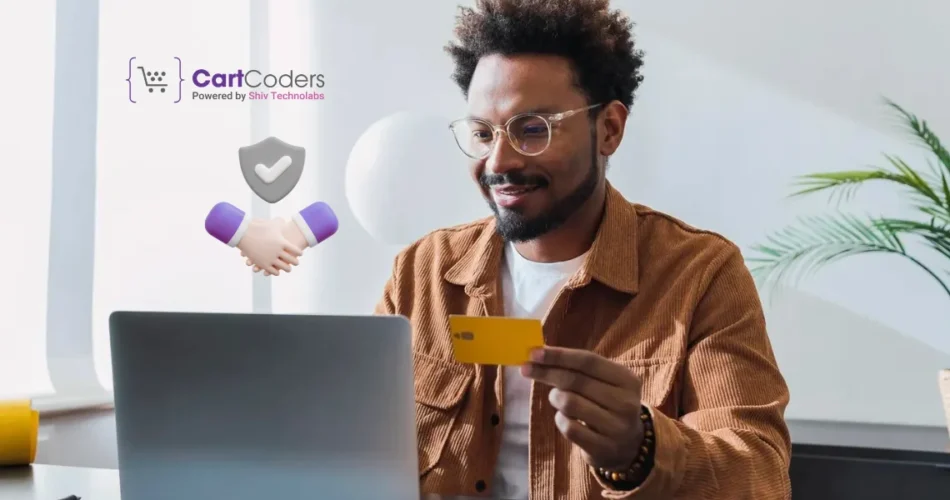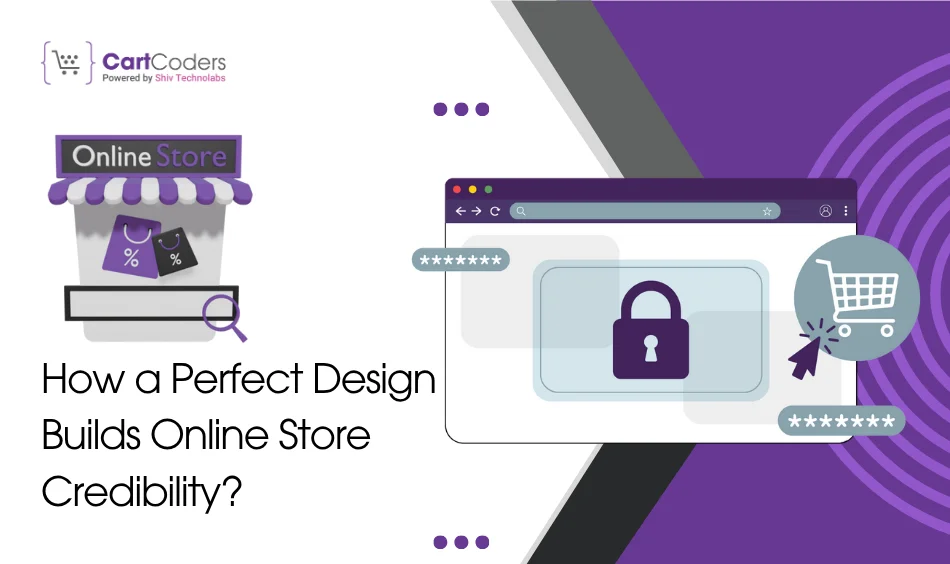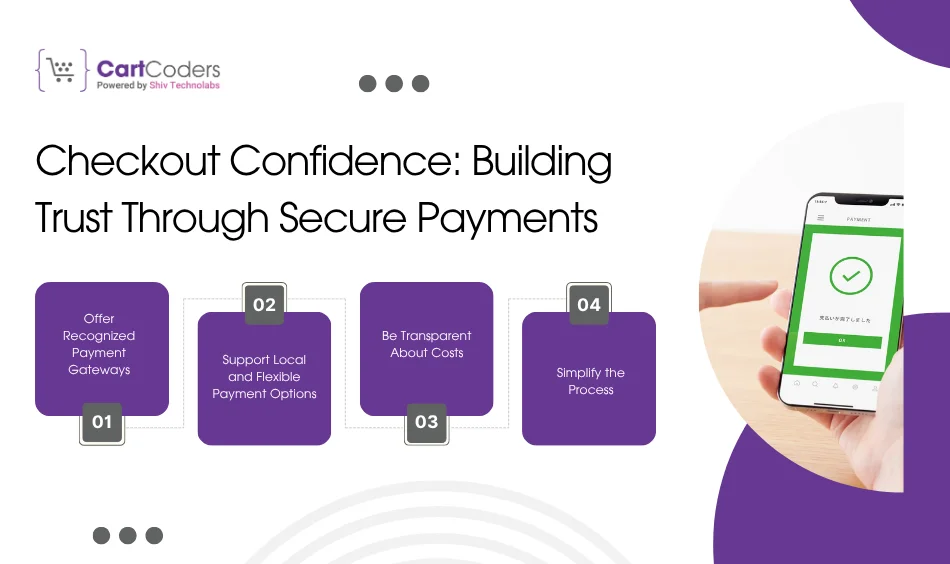Custom Engagement Solutions
Unlock tailored solutions with a free, no-obligation strategy session.
Expert Developers & Engineers on Demand
Scale Your Team with Skilled IT Professionals
Expert Guidance for Digital Transformation

You’ve launched your eCommerce store. The design looks sharp, products are ready, and ads start rolling. But despite all that, people browse — and leave without buying. Why? Because trust doesn’t come with a domain name.
When shoppers visit a new online store, they carry the same caution they would in a physical store they’ve never seen before. They look for signs that say, “This place is real, safe, and worth my money.” Without those cues, even the best prices or products can fail to convert.
A recent study by Baymard Institute found that 17% of online shoppers abandon their carts because they don’t trust the site with their payment information.
That single number explains a lot — trust is not a design element; it’s a feeling that shapes every click.
In this blog, we’ll break down what makes shoppers trust a new online store, the small details that quietly shape credibility, and how you can turn first-time visitors into long-term customers.
Whether you sell perfumes, groceries, fashion, or lifestyle products, trust is the thread that ties every successful eCommerce experience together.
Before trust is built, hesitation takes the lead. When people shop online, they can’t touch, feel, or test what they’re about to buy. So, they rely on signals — design, language, reviews, and responsiveness — to decide whether a store feels reliable or risky.
Unlike in physical shopping, where the store’s atmosphere and staff help form impressions, online trust is built through digital cues. Every visual choice, every word on the page, and every checkout step plays a part in convincing a visitor that they’re safe to proceed.
Think of it like this:
When these details are presented consistently, shoppers subconsciously relax. They feel that the store knows what it’s doing. That sense of predictability — not just discounts or visuals — is what sparks trust.
Trust online isn’t about technology — it’s about familiarity and consistency.
Understanding this mindset is the first step toward designing experiences that don’t just look good, but feel safe to buy from.

When shoppers land on a new store, they make a judgment in seconds. Before they read a single word, their eyes scan colors, layout, and visuals to decide whether the brand feels genuine or not. That’s why design is often the first trust signal — it tells visitors you care about their experience.
Shoppers trust what feels familiar. A store with clear menus, balanced colors, and real product photos instantly feels safer than one packed with flashing banners or stock images.
If you sell perfumes online, soft tones and elegant typography can evoke luxury and care.
An online grocery eCommerce store, on the other hand, benefits from bright colors and freshness-focused visuals. These subtle cues help buyers connect emotionally, even before they scroll.
A good design doesn’t try too hard to impress — it simply helps customers find what they came for.
Nothing breaks trust faster than confusion. Auto-playing videos, too many pop-ups, or cluttered product grids often make visitors doubt the store’s reliability.
Instead, keep the design clean and intuitive. Let your products take center stage.
When navigation is predictable, shoppers feel in control — and that feeling quietly converts visitors into confident buyers.
A polished design won’t replace genuine trust, but it lays the foundation for it. Once visitors feel comfortable browsing, they’re far more likely to move toward checkout.
Even the most beautifully designed store can struggle if it lacks clear trust signals. Shoppers need visible proof that they’re safe — and these small elements can quietly make or break their decision to buy.
Let’s look at the key trust indicators every new online store should display.
A store URL that starts with HTTPS instantly signals safety. That little padlock icon tells shoppers their payment details and personal data are encrypted. Without it, many won’t even proceed to checkout.
Displaying and integrating payment gateways like PayPal, Stripe, Apple Pay, or Razorpay assures buyers that trusted platforms handle their money. It removes one of the biggest fears — payment fraud.
Clear return, refund, and shipping policies help shoppers feel protected. When they know what to expect, they’re more likely to take the next step.
Example: “30-day return guarantee” sounds far more reliable than “No refunds after dispatch.”
Reviews act as digital word-of-mouth. Even a few genuine testimonials or product ratings can give new visitors the confidence to trust your store.
Encourage early buyers to leave photos or short feedback — they matter more than any marketing banner.
Showing an email address, phone number, or social media links adds human credibility. It says, “We’re real and reachable.”
A store that hides contact info often looks suspicious, no matter how attractive the design is.
By combining these signals thoughtfully, your store feels less like a website and more like a brand that customers can depend on.
A product page isn’t just a place to list features — it’s where trust either grows or disappears. Shoppers judge a store’s credibility by how confidently it presents each product. The more genuine your presentation feels, the stronger their intent to buy.
Shoppers can instantly spot staged or AI-generated photos. Use real product images, lifestyle shots, or short demo clips to show how your items look in real life.
For example:
Descriptions should speak like a salesperson, not a brochure. Mention the material, scent, or origin — avoid vague promises. Realistic wording builds trust faster than exaggerated claims.
Example: Instead of “World’s best floral fragrance,” say “Light jasmine notes ideal for daily wear.”
Hidden charges or unclear shipping timelines instantly kill trust. State delivery duration, additional fees, and stock availability upfront. Transparency saves you from abandoned carts and bad reviews.
Here’s a quick table showing what builds and breaks trust on a product page:
| Element | Builds Trust | Breaks Trust |
| Product Photos | Real lifestyle images | Stock or edited photos |
| Descriptions | Honest, detailed info | Generic or exaggerated text |
| Reviews | Verified buyer feedback | Anonymous or fake reviews |
| Pricing | Clear with taxes/shipping | Hidden costs |
| Return Policy | Easy to locate | Hard to find or missing |
When product details are genuine and predictable, shoppers feel safe enough to move from browsing to buying — without second thoughts.

Trust grows when customers feel they’re dealing with a real business, not just a digital storefront. Shoppers may forgive a late delivery or a missing product feature, but they rarely forgive silence or hidden details. That’s why transparency and authenticity are at the heart of long-term eCommerce success.
If an item is out of stock or delivery may take a few extra days, say it upfront. Hidden surprises break confidence, while honesty strengthens it. Even simple lines like “Ships in 5–7 days due to limited availability” make your store feel human.
People love knowing who’s behind the brand. Add short videos, packaging photos, or team introductions. A perfume store sharing how fragrances are bottled, or a grocery brand showing local sourcing, immediately builds emotional credibility.
Mistakes happen — orders get delayed, and stock runs out. What matters is how you communicate. A clear update email or WhatsApp message turns frustration into appreciation.
When customers see that you’re transparent even when things go wrong, they start trusting your store like a familiar brand.
Transparency turns hesitation into assurance. It reminds shoppers that behind every product page, there are real people who care about their experience.
People trust people more than they trust brands. That’s why social proof — reviews, testimonials, and visible engagement — plays such a powerful role in shaping buying decisions. For a new store, it’s the fastest way to show, not tell, that you’re dependable.
Even a handful of real customer reviews can make a difference. Shoppers look for experiences they can relate to — delivery quality, product accuracy, and packaging feedback.
Instead of waiting for dozens of reviews, start with a few authentic ones. Encourage early buyers to upload product photos or short video clips.
Example: A small perfume brand featuring three verified buyer testimonials with “real scent” mentions can earn more trust than a hundred generic reviews.
An active social media profile works as living proof of your brand’s legitimacy. Regular posts, replies to comments, and real customer interactions make your store feel alive.
When people see consistent activity on platforms like Instagram or TikTok, they stop viewing your business as ‘new’ and start seeing it as reliable.
You can also connect your store with your social channels — Shopify integrations allow displaying real-time Instagram feeds, customer photos, and tagged mentions.
This kind of visibility builds reassurance that your brand exists beyond the website.
Social proof doesn’t have to be loud — it just has to be real. Whether it’s a tagged post, a shared story, or a heartfelt review, each signal quietly tells shoppers: “Others trusted us, and so can you.”

The checkout process is where trust is tested the most. Even if a shopper loves your product, one small doubt about payment safety can stop the purchase instantly. That’s why a secure, transparent, and frictionless checkout design is a must for every new online store.
Display familiar logos like PayPal, Stripe, Apple Pay, or Razorpay. These symbols reassure customers that their money is handled through verified systems. Avoid redirecting users to third-party pages — keeping the checkout flow inside your site feels safer.
Regional payment preferences can make or break a sale. For example, buyers in Europe might prefer Klarna or Bizum, while customers in Asia often use Paytm or GPay. Supporting local methods builds cultural trust and makes the buying process smoother.
Unexpected charges appearing at the last step instantly reduce credibility. Always show the total price upfront — including taxes, shipping, or currency conversions. Clear pricing makes shoppers feel respected, which directly influences repeat purchases.
Keep checkout steps minimal. Long forms, unnecessary account creation, or unclear buttons raise suspicion. A well-designed one-page checkout improves both trust and conversions.
A secure, fast, and predictable checkout experience gives customers the final confidence to hit “Pay Now.” Once that happens, your store crosses the line between “new” and “trusted.”
Check Out Our Checkout Customizations Solutions!
Trust isn’t built overnight — it’s crafted through thoughtful design, reliable performance, and consistent communication. At CartCoders, we focus on helping eCommerce brands turn first-time visitors into returning customers through trust-led store experiences.
Our Shopify experts design and develop stores that feel professional, safe, and human. Every element — from layout to checkout — is built to inspire confidence and reduce friction.
Here’s what makes our approach effective:
If you’re planning to launch or revamp your eCommerce store, we can help you build it the right way — one that looks credible and earns customer confidence from day one.
Ready to build a Shopify store that customers instantly trust? Let’s make it happen — with CartCoders by your side.
Every new online store starts as an unknown name. What transforms it into a brand is not just design or pricing — it’s the small, consistent moments of reliability. From honest product pages to secure checkout and timely support, trust is built piece by piece.
For eCommerce founders, the goal isn’t just to attract visitors — it’s to make them feel safe enough to return. Once shoppers associate your store with clarity and care, price stops being their only reason to buy.
The truth is simple: trust isn’t a marketing strategy — it’s a habit. Build it with every click, every reply, and every promise kept.
Let’s connect today and build a trustworthy eCommerce store for your business!
Focus on real product photos, clear return policies, visible contact details, and safe payment options. Consistent communication and transparent delivery updates help build confidence quickly.
A clean design, verified reviews, secure checkout, and responsive customer support create a sense of safety. Shoppers trust stores that look professional and communicate openly.
Most buyers worry about product quality, payment safety, and delivery reliability. New stores must address these fears through transparent information and visible credibility signals.
Reviews are vital. Even a few genuine testimonials can make new shoppers feel confident. Verified reviews with buyer photos perform better than large volumes of generic comments.
Simple layouts, clear product categories, high-quality visuals, and visible brand consistency make your store appear credible. Avoid clutter, flashy animations, and confusing navigation.
Yes. Displaying trusted gateways like PayPal, Stripe, or Apple Pay helps buyers feel secure about transactions. Familiar logos act as instant reassurance during checkout.
Share clear shipping timelines, refund conditions, and return policies. Include behind-the-scenes photos or brand stories that show your real operations and people.
Hidden costs, unclear delivery details, fake scarcity counters, slow load speed, and missing contact information are the biggest trust breakers for new shoppers.
Deliver on promises, respond to concerns quickly, and stay consistent with your communication. Reliability across multiple orders gradually turns buyers into loyal customers.
Yes. CartCoders creates Shopify stores that build customer trust from day one — with secure checkouts, verified reviews, and conversion-focused design tailored to your niche.
Projects delivered in 15+ industries.
95% retention rate, building lasting partnerships.
Serving clients across 25+ countries.
60+ pros | 10+ years of experience.